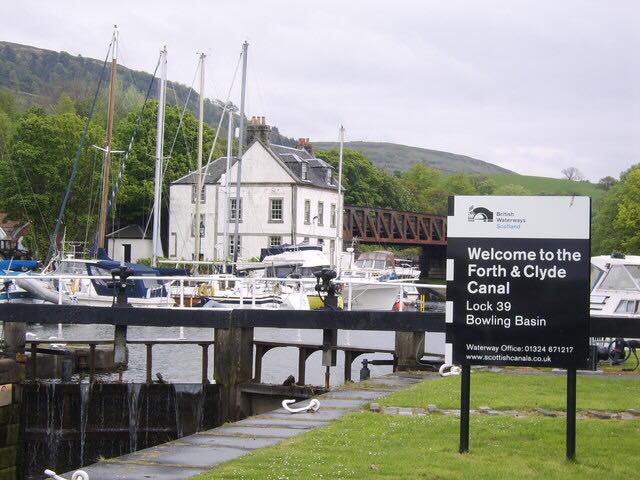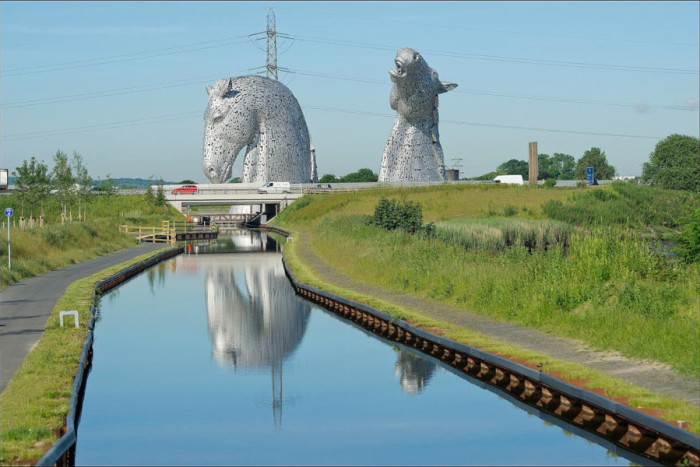Pre-2014, the Bowling harbour basin at the western entrance to the Forth and Clyde Canal had seen better days. The decline of what was a hub of activity in its industrial heyday had left it largely unused, neglected, and in need of some TLC. The Bowling basin harbour development, headed by Scottish Canals and West Dunbartonshire Council, has been breathing new life into the area through a regeneration programme which includes the development of housing, retail units, a cycle path and most recently plans for a “high line” park inspired by the New York model.
To date, more than £3.2 million has been invested in the project, which has included the transformation of disused railway arches into commercial business space and landscaping improvements to the lower basin area.
Designing with – not just for – the community
In 2014 a charrette was held (which its self was praised as excellent practice in local level co-production and co-design) in which residents and other stakeholders were invited not only to consult on plans for the regeneration, but to put forward their own ideas for what could potentially be done with the site and develop a shared master-plan for the area.
Partnership and co-production, as well as wide engagement across stakeholder groups were seen as central to the charrette process, and the transparency and regular engagement with local residents has ensured that the development not only meets the economic development needs set out by the council and Scottish Canals, but that it also fulfils the aspirations of local people.
A destination in its own right
One of the primary aims of the Bowling development was not just to rejuvenate the area, but to make Bowling a leisure and tourist destination in its own right. Retail units have been created within the refurbished arches of the railway bridge. Re-landscaped areas, to be developed into nature preservation sites, have been delivered, along with infrastructure which connects the harbour to the surrounding villages, the rest of the canal network, and the cycle network towards the Trossachs and Glasgow.
Most recently, an activity hub has been opened which includes opportunities for cycling, water sports and event space for clubs to meet, as well as “The Dug Café”, a dog friendly coffee shop. It is hoped the offering of retail, outdoor activities and connectivity to the rest of the canal network, as well as Glasgow will encourage more people to visit Bowling. It is also hoped the project will act as a new focus point for members of the community, linking to schools and employment opportunities for local people and businesses.
Scotland’s High Line
The New York High Line is a 1.45-mile-long linear park which runs through Manhattan on the former New York Central Railroad. In October 2017, proposals were submitted for planning approval for Bowling’s very own high line, using the iconic 120-year-old swing bridge. The railway fell into disrepair in the 1960s, but with funding support from Sustrans and Historic Environment Scotland, Scottish Canals has undertaken repairs to the structure’s metalwork and repainted the entire span. The plans include new viewpoints which will offer visitors the chance to enjoy the vistas over the canal and River Clyde. The new route will form a direct link between the Forth & Clyde Canal and the National Cycle Network route heading towards Loch Lomond and The Trossachs National Park.
Looking to the future…
Scottish Canals are keen to stress the potentially vial role they can play in revitalising Scotland’s waterside environments. With a large landholding and significant scope for supporting regeneration projects, they are becoming an increasingly major player. They view the areas along Scotland’s canal network as opportunities not only to use innovative techniques such as custom build projects to improve the physical environment around waterways and canals, but also to support and create positive places and opportunities for local communities.
Scottish Canals are also involved in developments at Dundas Hill in Glasgow, as well as a number of projects across the canal network in Scotland.
Follow us on Twitter to see what developments are interesting our research team.
If you enjoyed this blog, you may also be interested in our other articles:
SURF conference 2017 – What Scotland has learned from 25 years of regeneration
Share
Related Posts
Tackling geographical inequalities is critical for ensuring that all parts of the country have the potential to prosper. When the UK was a member of the European Union, it was entitled to a share of funding from the EU’s structural ....
By Ian Babelon A new-old concept for proximity “Are we there yet?” Parents may patiently nod to their children’s insistent nudges on a 20-minute journey to… somewhere. Quite rightly, researchers have asked: twenty minutes to what? The answer may well ....
By Ian Babelon In the first part of two blog posts, published on 22 May, Ian Babelon provided examples of good practice in retrofitting social housing. The second part of this blog post looks at estate-wide and area-wide social housing ....
By Ian Babelon In the first of two blog posts, Idox’s Ian Babelon takes us on a tour of some of the best social housing retrofits in Britain, and beyond. Blog posts on the Knowledge Exchange blog have repeatedly shown ....




